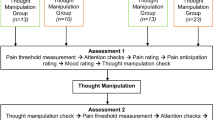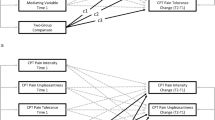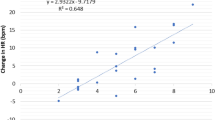Abstract
Thirty volunteers participated in cold-pressor pain hand-immersions to investigate the effects of moods on imaginai model interventions. Participants (N = 30) were randomly assigned to one of three treatments. Pleasant and unpleasant imageries induced participant mood states. Participants experienced either (a) pleasant imaginai scenes followed by imaginai models, (b) unpleasant imaginai scenes followed by imaginai models or, (c) no intervention. Two-way repeated measures analyses of variance (ANOVAS) and a one-way multivariate analysis of variance (MANOVA) were conducted. Unpleasant mood induction participants reported more negative moods (i.e., sadness, worry) than no treatment controls. Pleasant mood induction participants reported a significant decrease in anger. Pleasant mood induction participants showed significant increases in pain tolerance after treatment. Other groups showed nonsignificant differences in ability to tolerate pain. Hypotheses are given for the results. Results suggest that pleasant moods may have beneficial effects on pain coping interventions.
Similar content being viewed by others
References
ALBRIGHT, G. L., & FISCHER, A. A. (1990). Effects of warming imagery aimed at trigger-point sites on tissue compliance, skin temperature, and pain sensitivity in biofeedback trained patients with chronic pain: A preliminary study. Perceptual and Motor Skills, 71, 1163–1170.
BERNTZEN, D. (1987). Effects of multiple cognitive coping strategies on laboratory pain. Cognitive Therapy and Research, 11, 613–623.
CAUTELA, J. R. (1970). Covert reinforcement. Behavior Therapy, 1, 33–50.
CAUTELA, J. R. (1977). The use of covert conditioning in modifying pain behavior. Journal of Behavior Therapy and Experimental Psychiatry, 8, 45–52.
CAUTELA, J. R. (1986). Covert conditioning and control of pain. Behavior Modification, 10, 205–217.
CAUTELA, J. R., & FLANNERY, R. B. (1974). Covert modeling: An experimental test. Behavior Therapy, 5, 494–502.
CHEN, A. C. N., DWORKIN, S. F., HAUG, J., & GEHRIG, G. (1989). Human pain responsivity in a tonic pain model: Psychological determinants. Pain, 37, 143–160.
DUBREUIL, D. L., ENDLER, N. S., & SPANOS, N. P. (1987). Distraction and redefinition in the reduction of low and high intensity experimentally-induced pain. Imagination, Cognition and Personality, 7, 155–164.
EICH, E., RACHMAN, S., & LAPOTKA, C. (1990). Affect, pain, and autobiographical memory. Journal of Abnormal Psychology, 99, 174–178.
FERGUSON, G. A., & TAKANE, Y. (1989). Statistical analysis in psychology and education (6th ed.). New York: McGraw-Hill.
FERNANDEZ, E., & TURK, D. C., (1989). The utility of cognitive coping strategies for altering pain perception: A meta-analysis. Pain, 38, 123–135.
GRACELY, R. H., MCGRATH, P., & DUBNER, R. (1978). The ratio scales of sensory and affective verbal pain descriptors. Pain, 5, 5–18.
GRIMM, L., & KANFER, F. H. (1976). Tolerance of aversive stimulation. Behavior Therapy, 7, 593–601.
HATAYAMA, T., SHIMIZU, K., & OHYAMA, M. (1989). Effects of thermal imagery on experimental pain using a constant radiant heat. Japanese Journal of Physiological Psychology and Psychophysiology, 7, 19–25.
HEKMAT, H. (1988). Goal specificity and pain tolerance: Paradigmatic behavior therapy perspective. Paper presented at 22nd annual Association for Advancement of Behavior Therapy Annual Convention, New York, NY.
HEKMAT, H., & HERTEL, J. B. (1990). Pain tolerance: Reflections on gender issues. Poster presented at the American Psychological Association’s 98th Annual Convention, Boston Mass.
HEKMAT, H., & HERTEL, J. B. (1993). Pain attenuating effects of preferred versus nonpreferred music interventions. Psychology of Music, 21, 163–173.
HILGARD, E. R. (1969). Pain as a puzzle for psychology and physiology. American Psychologist, 24, 103–113.
HILGARD, E. R. (1975). The alleviation of pain by hypnosis. Pain, 1, 213–231.
HODES, R. L., HOWLAND, E. W., LIGHTFOOT, N., & CLEELAND, C. S. (1990). The effects of distraction on responses to cold-pressor pain. Pain, 41, 109–114.
HOLMES, J. D., HEKMAT, H., & MOZINGO, B. S. (1983). Cognitive and behavioral regulation of pain: The facilitatory effect of analgesic suggestion. The Psychological Record, 33, 151–159.
KAZDIN, A. E. (1974). Covert modeling, model similarity, and reduction of avoidance behavior. Behavior Therapy, 5, 325–340.
MIRO, J., & RAICH, R. M. (1992). Personality traits and pain experience. Personality and Individual Differences, 13, 309–313.
MURRAY, F. S., & HAGEN, B. C. (1973). Pain threshold and tolerance of hands and feet. Journal of Comparative Physiological Psychology, 84, 639–643.
NEWSHAN, G., & BALAMUTH, R. (1991). Use of imagery in a chronic pain outpatient group. Imagination, Cognition, and Personality, 10, 25–38.
RAFT, D., SMITH, R. H., & WARREN, N. (1986). Selection of imagery in the relief of chronic and acute clinical pain. Journal of Psychosomatic Research, 30, 481–488.
SPANOS, N. P., & O’HARA, P. A. (1990). Imaginai dispositions and situation-specific expectations in strategy-induced pain reductions. Imagination, Cognition, and Personality, 9, 147–156.
STAATS, A. W. (1986). Behaviorism with a personality: The paradigmatic behavioral assessment approach. In R. O. Nelson & S. C. Hayes, Conceptual foundation of behavior assessment (pp. 242–296). New York: The Guilford Press.
STAATS, A. W. (1988). Paradigmatic behaviorism, unified positivism and paradigmatic behavior therapy. In D. B. Fishman, F. Rotgers, & C. M. Franks (Eds.), Paradigms in behavior therapy: Present and promise (pp. 211–253). New York: Springer.
STAATS, A. W. (1991). Paradigmatic behavior therapy: A unified framework for theory, research, and practice. In G. H. Eifert & I. M. Evans (Eds.), Unifying behavior therapy: Contribution of paradigmatic behaviorism. New York: Springer.
STEVENS, M. J. (1985). Modification of pain through covert positive reinforcement. Psychological Reports, 56, 711–717.
STEVENS, M. J., HEISE, R. A., & PFOST, K. S. (1989). Consumption of attention versus affect elicited by cognitions in modifying acute pain. Psychological Reports, 64, 284–286.
STEVENS, M. J., PFOST, K. S., & RAPP, B. J. (1987). Modifying acute pain by matching cognitive style with cognitive treatment. Perceptual and Motor Skills 65, 919–924.
ZELMAN, D. C., HOWLAND, E. W., NICHOLS, S. N., & CLEELAND, C. S. (1991). The effects of induced mood on laboratory pain. Pain, 46, 105–111.
Author information
Authors and Affiliations
Additional information
This research study was carried out at the Department of Psychology, University of Wisconsin-Stevens Point. James B. Hertel is presently a counseling psychology doctoral candidate at the Department of Educational and Counseling Psychology at the University of Missouri-Columbia. Hamid M. Hekmat is a professor of psychology at the University of Wisconsin-Stevens Point. We gratefully acknowledge Paul B. Gold for his editorial comments in preparation of this manuscript.
Rights and permissions
About this article
Cite this article
Hertel, J.B., Hekmat, H.M. Coping with Cold-Pressor Pain: Effects of Mood and Covert Imaginal Modeling. Psychol Rec 44, 207–220 (1994). https://doi.org/10.1007/BF03395128
Published:
Issue Date:
DOI: https://doi.org/10.1007/BF03395128




